“Global AI In Energy Market to reach a market value of USD 63.6 Billion by 2031 growing at a CAGR of 29.5%”
The Global AI In Energy Market size is expected to reach $63.6 billion by 2031, rising at a market growth of 29.5% CAGR during the forecast period.
As the energy industry continues to evolve and embrace automation, the robotics segment is expected to grow significantly, driven by the need for innovative solutions to address complex energy management and infrastructure development challenges. Thus, in 2023, the robotics forecasting segment held 21% revenue share in the AI in energy market. Robotics applications in the energy sector are becoming increasingly prevalent, focusing on automating tasks that enhance operational efficiency and safety. For instance, robotic systems can conduct inspections, perform maintenance on infrastructure, and facilitate the deployment of renewable energy technologies. By integrating AI with robotics, energy companies can achieve higher accuracy in operations, reduce labour costs, and minimize risks associated with human error in hazardous environments.
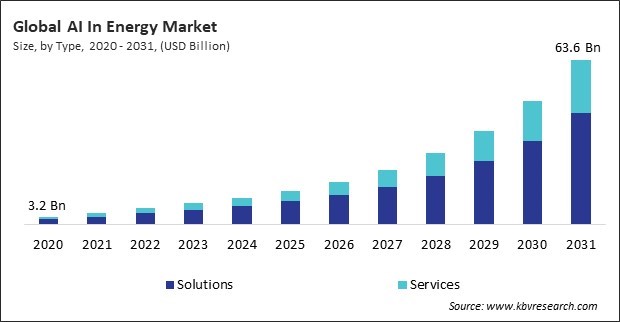
The major strategies followed by the market participants are Partnership as the key developmental strategy to keep pace with the changing demands of end users. For instance, In October, 2024, Honeywell International has teamed up with Chevron, a leading energy company, to develop advanced AI-assisted solutions aimed at enhancing refining operations. This collaboration will introduce new alarm management technologies that guide operators in decision-making, improving efficiency, safety, and reliability within industrial automation. The integration of AI into Honeywell’s Experion® distributed control system will help address workforce shortages and enhance operational effectiveness, marking a significant step forward in refining processes and industry innovation. Additionally, In October, 2024, Amazon Web Services partnered with Dominion Energy, a leading utility company, to explore the use of small modular reactors for powering data centers. This collaboration aims to enhance clean electricity sourcing amid surging demand for AI and data processing.
Based on the Analysis presented in the KBV Cardinal matrix; Microsoft Corporation and Google LLC are the forerunners in the AI In Energy Market. Companies such as Amazon Web Services, Inc., Siemens AG, Schneider Electric SE are some of the key innovators in AI In Energy Market. In October, 2024, Google has partnered with Kairos Power, a nuclear power developer, to develop small modular reactors aimed at supporting its AI operations with a target of 500 megawatts by 2035. This partnership seeks to diversify energy sources to meet the increasing demands of AI technologies, ensuring a reliable and sustainable power supply for Google's ambitious AI initiatives.
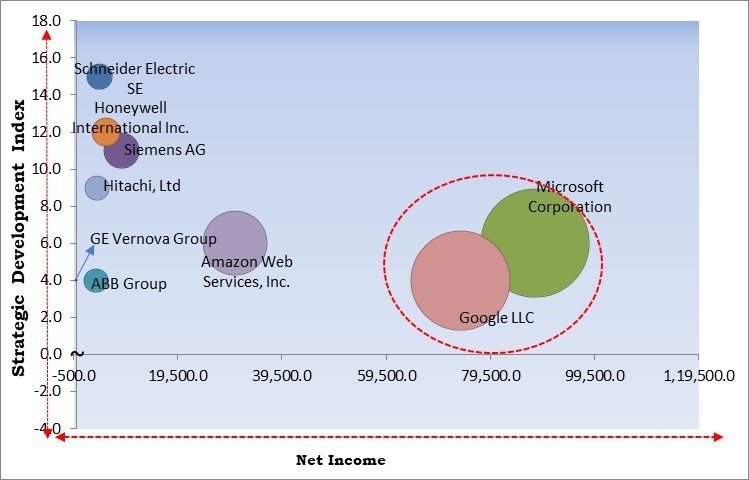
Growing awareness of climate change and its adverse impacts has prompted individuals, corporations, and governments to prioritize sustainability. The quest for cleaner energy sources and reduced greenhouse gas emissions has led to a fundamental shift in how energy is produced and consumed. AI technologies are instrumental in identifying inefficiencies and optimizing processes, enabling energy companies to meet sustainability targets while maintaining profitability.
Additionally, the impacts of climate change are becoming more evident, with extreme weather events such as hurricanes, floods, wildfires, and heat waves occurring more frequently. These events can severely disrupt the energy supply and compromise the integrity of the grid. As a result, energy providers are compelled to invest in technologies that enhance the resilience of their infrastructure. Thus, the rising need for grid resilience and disaster recovery solutions propels the market's growth.
Implementing AI solutions in energy production and management often requires substantial upfront capital investments. These investments encompass costs related to advanced hardware, software licenses, system integration, and the training of personnel to operate and maintain new technologies. Many energy companies, particularly smaller players, may find it challenging to allocate the necessary funds, limiting their ability to adopt AI solutions. Therefore, high initial investment costs and economic viability concerns hamper the market's growth.
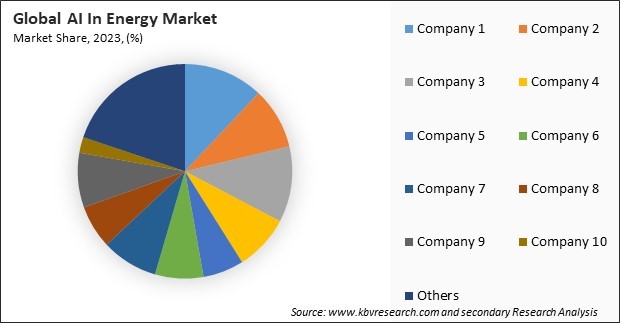
The leading players in the market are competing with diverse innovative offerings to remain competitive in the market. The above illustration shows the percentage of revenue shared by some of the leading companies in the market. The leading players of the market are adopting various strategies in order to cater demand coming from the different industries. The key developmental strategies in the market are Partnerships & Collaborations.
Based on application, the market is categorized into robotics, renewable energy management, demand forecasting, safety security & infrastructure, and others. In 2023, the renewable energy management segment registered 28% revenue share in the market. This segment focuses on utilizing AI technologies to optimize integrating and managing renewable energy sources, such as solar and wind power.
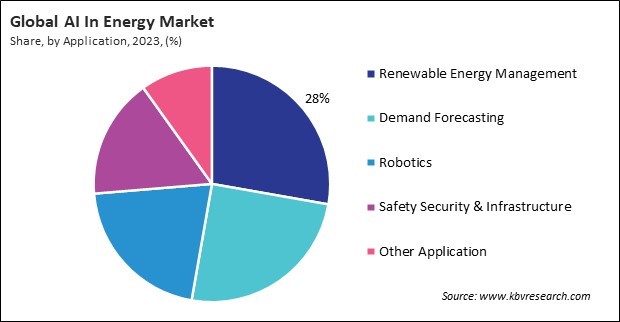
On the basis of type, the market is segmented into solutions and services. In 2023, the services segment attained 30% revenue share in the market. This segment includes consulting, implementation, and support services vendors provide to help organizations adopt and integrate AI technologies effectively.
Free Valuable Insights: Global AI In Energy Market size to reach USD 63.6 Billion by 2031
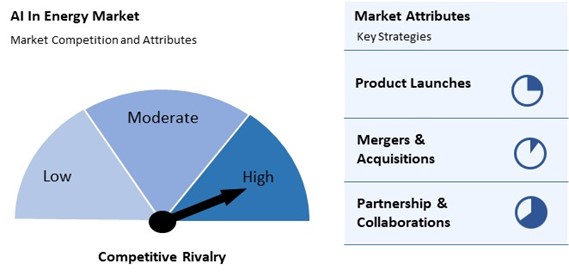
The AI in energy market is highly competitive, driven by rapid innovation and an increasing focus on sustainable energy solutions. Key attributes include advanced analytics, predictive maintenance, and energy optimization, enabling companies to reduce costs and carbon emissions. Competition revolves around developing efficient, scalable AI-driven solutions for energy management, grid automation, and demand forecasting. Market players prioritize partnerships, R&D, and regulatory compliance to secure a competitive edge, as well as user-friendly platforms that simplify AI integration in energy systems.
Region-wise, the is analyzed across North America, Europe, Asia Pacific, and LAMEA. In 2023, the Europe region generated 30% revenue share in the market. The European market is characterized by aggressive policies to transition to renewable energy sources and reduce greenhouse gas emissions. Countries across Europe invest heavily in AI technologies to facilitate this transition, focusing on applications such as renewable energy management, demand forecasting, and energy efficiency optimization.
| Report Attribute | Details |
|---|---|
| Market size value in 2023 | USD 8.4 Billion |
| Market size forecast in 2031 | USD 63.6 Billion |
| Base Year | 2023 |
| Historical Period | 2020 to 2022 |
| Forecast Period | 2024 to 2031 |
| Revenue Growth Rate | CAGR of 29.5% from 2024 to 2031 |
| Number of Pages | 209 |
| Number of Tables | 273 |
| Report coverage | Market Trends, Revenue Estimation and Forecast, Segmentation Analysis, Regional and Country Breakdown, Competitive Landscape, Market Share Analysis, Porter’s 5 Forces Analysis, Company Profiling, Companies Strategic Developments, SWOT Analysis, Winning Imperatives |
| Segments covered | Type, Application, Region |
| Country scope |
|
| Companies Included | Siemens AG, ABB Group, Schneider Electric SE, GE Vernova Group, Hitachi, Ltd, Honeywell International Inc., Amazon Web Services, Inc. (Amazon.com, Inc.), Google LLC, Microsoft Corporation and AutoGrid Systems, Inc. |
By Type
By Application
By Geography
This Market size is expected to reach $63.6 billion by 2031.
Increased demand for energy efficiency and sustainability in energy production are driving the Market in coming years, however, High initial investment costs and economic viability concerns restraints the growth of the Market.
Siemens AG, ABB Group, Schneider Electric SE, GE Vernova Group, Hitachi, Ltd, Honeywell International Inc., Amazon Web Services, Inc. (Amazon.com, Inc.), Google LLC, Microsoft Corporation and AutoGrid Systems, Inc.
The expected CAGR of this Market is 29.5% from 2024 to 2031.
The Solutions segment is leading the Global AI In Energy Market by Type in 2023; thereby, achieving a market value of $42.9 billion by 2031.
The North America region dominated the by Region in 2023, and would continue to be a dominant market till 2031; thereby, achieving a market value of $23.4 billion by 2031
Our team of dedicated experts can provide you with attractive expansion opportunities for your business.

 Drivers
Drivers
 Restraints
Restraints
 Opportunities
Opportunities
 Challenges
Challenges
